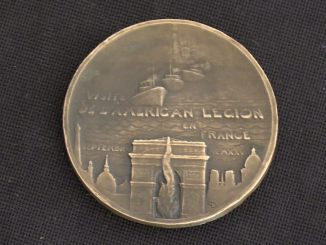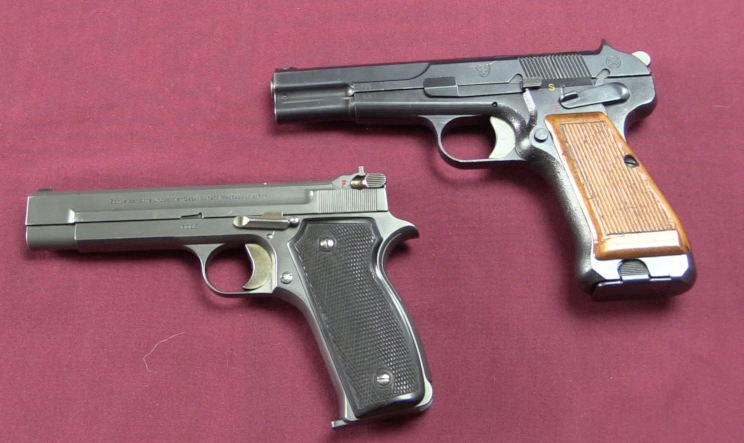Courtesy of the French Ministry of the Interior, we have a chance to take a look at an authentic GIGN sniper model MR73 revolver today. GIGN is the elite intervention element of the French Gendarmerie, akin to GSG9 in Germany or the FBI Hostage Rescue Team in the US. Back in the 1970s, the service was looking for a standard sidearm, and wanted something capable of significant stopping power, immediate use from the holster, maximum accuracy, and an exceptionally long lifespan. The .357 Magnum cartridge was chosen, and the Manurhin company designed the MR-73 revolver specifically to provide the desired accuracy and the durability to maintain that accuracy through years of daily training use.
The MR73 was purchased and used mostly with 4″ and 5″ barrels, but a small number were also purchased by GIGN with 8″ barrels, to be made into scoped sniper models. These were fitted with a Harris bipod on custom mount, and a Bushnell 2.5x pistol scope. Outfitted this way, they were capable of pinpoint precise shots in very tight quarters where a rifle would not be a practical option. They were not meant to replace rifles in all situations; GIGN is one of those elite agencies with great latitude in arms procurement. This scoped revolver was one of many options available in their arsenal, for particular situations calling for it.
That said, GIGN have deliberately cultivated the image of being first-tier operators who deliberately choose to use the revolver as a powerful and classy old-school weapon – although this is mostly done for ceremonial duties today.




Over here, we’d call this the ultimate jackrabbit/prairie dog revolver.
Coyotes should beware, as well.
cheers
eon
Typical French thing – as unconventional as possible – but for a purpose.
Btw. before this I watched on Y-T Ian’s debate with Nick the Tanker in Alamo. Very interesting and both men tune well with each other. In free discussion, Ian appears to be witty person and title befitting to him in my mind would be Mephisto rather that of the notorious religious character. Definitely, there is a lot of Chi (energy).
I would love to see a photo of the holster for this revolver.
I just finished reading an excellent french crime novel les arnagueurs aussi which translates out as the scammers scammed. On page 432 they mention the MR73 the translation is the MR 73 you shouldnt laugh at it because its old school Tt was precise and fired a large cartrige
The mr 73 even today is part of the lore of french crime novels and films
A big oversight I think, is that the revolver seems to lack the ability to launch rifle grenades.
I wonder if any have made it to the civilian market?
The Gendarmerie has been surplussing MR-73 revolvers from time to time over the last few years and before that a small number was offered on the normal civilian market in Europe at least, but revolvers have never sold that well in Europe and the MR73 had competition from the likes of the cheaper Colt Python or various even cheaper Rugers or S&W. If I was not already owning a Ruger in .357 to put down wounded game, I would seriously consider buying a surplussed MR-73.
“Major Advantage”? The majority of speed-shooters (everywhere they’re legal) uses 1911s or equivalents. Yet somehow a scoped SNIPER revolver on a bipod must be used in such haste that a longer, heavier (even custom) DA pull is preferable to an ergonomically placed safety or hammer? On the contrary, the sniping / overwatch role optimally showcases a manual safety’s value as a “mode switch”.
I’m surprised expert shooters like GIGN didn’t incorporate a folding, collapsing, or quick-detach handgun stock. I’m also surprised they didn’t carry the freedom / flexibility Ian mentioned to its logical conclusion: fitness for purpose (sniper / DMR vs. airliner CQB) over broad-brush standardization. Of the weapons available / feasible in 1973, I’d probably have chosen a short-barreled M1A1 Carbine with a cheek rest in addition to the scope and bipod.
Well, first of all a stock would make it as long as a carbine, which kind of negates the whole “get it into an area where a rifle won’t fit” thing. The folding bipod renders a shoulder stock mostly irrelevant if firing from a hide, using a solid rest like a window sill, concrete stair rail, etc.
Second, I’d assume that any countersniping etc. shooting with this would be done single-action, not double-action. However, you’d want the double action in case a fast but not quite as precise follow-up shot was needed. Depending on the dreamed-of “one-shot stop” is bad policy.
As far as super-accurate shooting goes, I could see something like a Remington XP-100 in 7mm RBR with a 12X scope being used for that first very precise shot- with this revolver’s scope being used to “spot” by the spotter, who could then follow up as necessary.
cheers
eon
“Well, first of all a stock would make it as long as a carbine, which kind of negates . . .” – well, not if it was folded, collapsed, or detached, which is why I specified. I’m not sure if you’ve ever shot a pistol off a bipod, but I have, and disagree on it being so accurate as to make a riflestock irrelevant. Admittedly, mine had a lot more recoil than the MR73 (.30-06).
I agree that they’d probably fire the first shot SA (negating the supposed “Major Advantage” of DA) – but I’d also contend that they’d get your second shot off faster AND more accurately from an SA autoloader.
“Of the weapons available / feasible in 1973, I’d probably have chosen a short-barreled M1A1 Carbine with a cheek rest in addition to the scope and bipod.”
But would it work reliably with special bulleted cartridge, for example hollow point?
Would be 1970s automatic pistols be able to do that?
One of advantages of choosing revolver was that it work equally well with any type of bullet. In that particular use ability to use bullet with lesser chance of excessive penetration and/or ricochet might be deemed important (collateral damage control).
An organization with GIGN’s resources and clout could surely manage to get their feed ramps polished, a fairly routine / inexpensive gunsmithing job compared to all the work that seems to have gone into these MR73s.
Alternatively (or cumulatively), at carbine velocities one could use a more tapered hollow or soft point to achieve the requisite terminal ballistics.
I would probably have employed a Remington 700, in 7MM Mag, or 300Win Mag.
Many S.W.A.T. teams use these, along with other groups. They do however, use it it the .308, as well.
Do law enforcement agencies have obsessions with big irons?
Of course they do – it’s part of their trade; the bigger the better. Their sensibilities are the same as rest of population. Some are collectors albeit of more modern stuff.
Just to give you idea for how much goes MR73 in Canada.
https://store.theshootingcentre.com/manurhin-mr73-sport-357-mag-4-25-wood-grip-revolver
Most self-loading pistols are around 1k.
Unfortunately, it’s generally easier to build a quality self-loader with modern production methods than it is to build a quality revolver.
On that count alone, in the future, the high-quality revolver may end up as a plaything of the idle rich, as Michel Josserand and Jan Stevenson predicted in Pistols, Revolvers, and Ammunition in 1972.
https://archive.org/details/Pistols_Revolvers_Ammunition_By_Michel_Josserand_Jan_Stevenson
cheers
eon
Unless you’re playing as a cowboy, hard-boiled detective, or classic cop in the movies, forget the magnum revolver altogether at this point… I could be wrong.
They still have a niche role in handgun hunting. Enough power to do the job, six rounds is plenty, usually have good sights, and in single action usually have a really good trigger pull.
In Canada all short weapons are routinely more costly than Stateside. One reason might be size of market.
Glad to see that they’re still available for sale today. Not that I’ll ever be able to afford one.
Wow the french Ministry of the Interior, Mr. McCollum’s net of friends is growing everywhere and now includes State organizations ! Good Job !
The MR 73 is legendary for those that watched french actions flicks from the 70’s and 80’s mostly but the GIGN is the number one factor of fame for these weapon and for good reasons.
Superb vid, thanks.
MR73 was also the selected sidearm of G.E.O. (Grupo Especial de Operaciones) of the Spanish National Police when it was founded in the late 70s, until being replaced by HK P9S.
In greater historical scope I am surge the elite GIGN force foiled many attacks on public and people of special interest. I am not sure however how successful (if at all) they were in November of 2015. Result of widespread terrorist’s attacks were more that 120 civilians dead and many more wounded. https://en.wikipedia.org/wiki/November_2015_Paris_attacks
Interestingly, out of 8 attackers 7 were killed by own hand instead by police bullets. But then, lately we do not hear much of similar actions; perhaps the public security had been beefed up substantially since. Let’s hope.
Any and all of the world’s “counterterrorism” units would have done nothing in such situation. They are never first responders. I am not sure what is exactly premier American counterterrorism unit, but surely they had nothing to do with the prevention of Boston Marathon bombing. Such things are prevented either by the intelligence agencies (not by the flashy stormtroopers, but by boring people sitting in boring offices) or by local cops who are nearby and can react in minutes.
Half Life vibes…
LOL, the “357 Magnum” was a longer range weapon than the rifles. Python based rather than MR73.
Don’t forget the whip the cylinder open/closed & spin it upon reload, kids!
To the extent that we can trust Dick Marcinko’s autobiography “Rogue Warrior”, he claimed that the very first iteration of Seal Team 6 used S&W Model 66 revolvers in .357 Magnum.
They were stainless (salt spray environment, and all that), they were reliable, and rugged. And while he said they shot tens of thousands of rounds through them for training, they could also replace them as needed.
With all that bells and whistles i wonder there is no bayonet on this piece. Swiss army knife would be nice.
A superb gun for what it was / its purpose – a good example of taking disparate elements to perfectly fit a specific / specialized requirement. Who cares if some of these look somewhat archaic – if worked and did so very well.